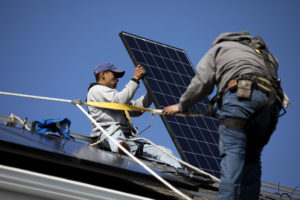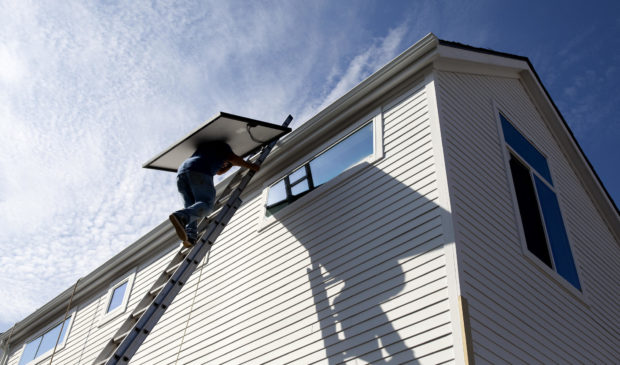Austin revamps solar rebate program as White House levies new tariffs on panels
Tuesday, February 6, 2018 by
Mose Buchele, KUT At a new 28-home development in East Austin, workers for Lighthouse Solar pull solar panels from the back of a trailer, haul them to a ladder, and then carry them 30 feet up to the recently shingled rooftops where they’ll be installed.
It’s a fun job, said Tyson Bagio, as long as you’re not afraid of heights. Bagio just finished up five years in the Army and recently started working in the field.
“‘Solar electrician’ sounded pretty cool, so I joined, and I’m loving it so far,” he said. “I learn something new every day. Solar is constantly changing.”
But some changes may not be welcome. New tariffs on solar panels announced by the Trump administration last month will make many solar projects more expensive. And the tariffs come as city rebates for solar are being phased out in Austin.
 The uncertainty about the impacts of both moves has left some consumers wondering whether now is a good time to install solar panels.
The uncertainty about the impacts of both moves has left some consumers wondering whether now is a good time to install solar panels.
“There are sort of multiple signals impacting people’s understanding of where this (is) all going,” said Stan Pipkin, one of the owners of Lighthouse Solar.
Pipkin said his company started feeling pain from the tariffs before they were even finalized, when companies started stockpiling solar equipment.
“There’s been a run on modules,” he said, referring to the panels. “It’s been a scramble to find the equipment that goes into our projects.”
Ironically, that may end up hurting companies like his more than the increased costs brought on by the tariffs themselves, which ended up not being as high as some feared.
“When it comes down to it, I think it’s really only going to raise cost for a residential installation by 3 to 5 percent,” said Danielle Murray, manager of solar energy services for Austin Energy.
It’s not a great increase considering how much the cost of solar has fallen over the last 10 years. But it’s that same price decline that’s responsible for the end of the city’s solar incentive program.
“We are getting to a point where it’s cost-effective enough that you don’t necessarily need incentives,” Murray said. “We need to keep in mind that those incentives are coming out of our rates. It comes from our ratepayers, the customers.”
But the end of the current program doesn’t mean the end of all incentives.
The way the current rebate program works, the amount of money the city gives back to people depends on the capacity of the project they install. The more energy it generates, the bigger the rebate.
Austin wants to switch to a flat, one-time payment. At an Electric Utility Commission meeting last month, Murray said that might be around $2,000 per project.
Some at the meeting worried a single payment could discourage big residential solar projects. But, Murray said, it should allow the city to spread rebates to more people, even if they don’t have money for a huge solar investment.
“We’re moving toward … a little more streamlined process,” she said, “and hopefully something that’s a little more equitable across our customers to get them over that upfront cost barrier to help them install solar.”

You might imagine that the businesses that have benefited from Austin’s current program would oppose the shift. But Pipkin said it makes sense.
At the very least, he said, a one-time rebate will be easier to communicate to customers than an incentive pegged to the energy a panel can generate.
“We’re excited about that,” Pipkin said. “We’re just expectant to see when that happens … you know, we have people who are interested in preparing for the summer. They want to do solar this spring.”
Despite the short-term uncertainties, he said, the future is bright for solar in Austin.
Back at the East Austin worksite, Bagio agrees.
“It’s the future,” he said.
The city of Austin hopes to have its new residential solar program in place in April.
The headline of this article has been changed. A spokesperson from Austin Energy clarified that they are not “phasing out” the program, but “revamping” it. This story was produced as part of the Austin Monitor’s reporting partnership with KUT. Photos by Austin Price/KUT.
The Austin Monitor’s work is made possible by donations from the community. Though our reporting covers donors from time to time, we are careful to keep business and editorial efforts separate while maintaining transparency. A complete list of donors is available here, and our code of ethics is explained here.
You're a community leader
And we’re honored you look to us for serious, in-depth news. You know a strong community needs local and dedicated watchdog reporting. We’re here for you and that won’t change. Now will you take the powerful next step and support our nonprofit news organization?





